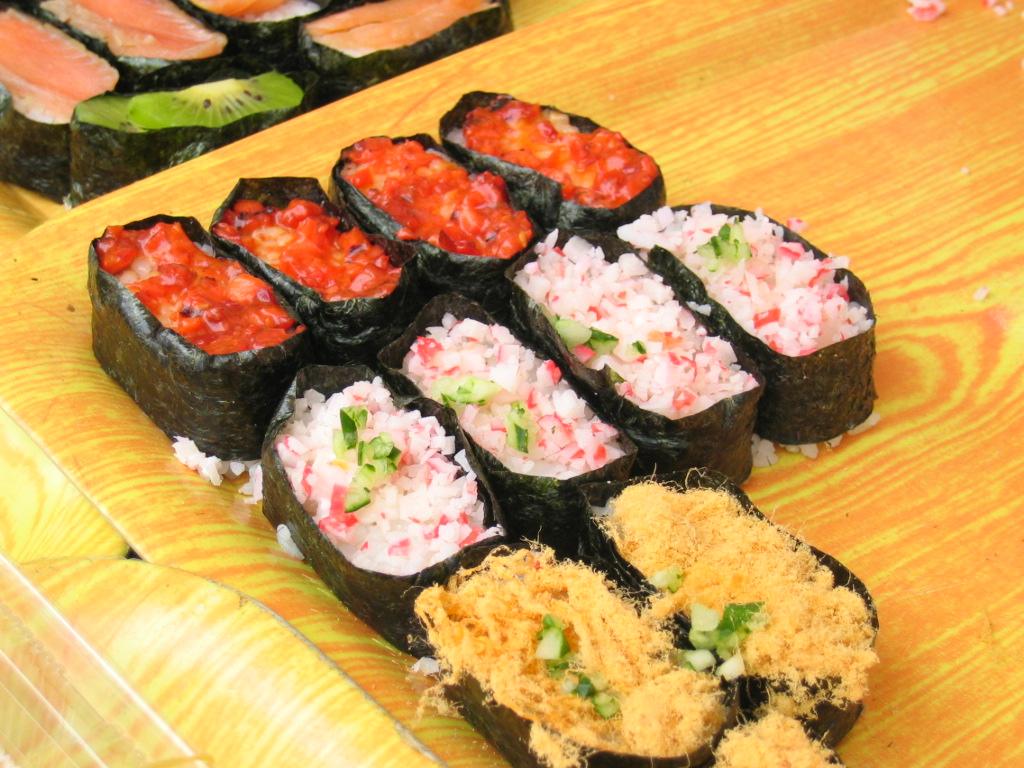基本介紹
- 中文名:Suchi壽司
- 主要原料:米飯跟魚
- 國家:日本
- 類型:壽司
The Story of Sushi,壽司物語,最普通的壽司形式,吃壽司的簡單法則,
The Story of Sushi
Inside a Japanese sushi bar, a long train of plates passesbefore the eyes of customers. The elegant and colorful arrangements are a feast for the eyes, just as the sushi is a delight to the taste buds. While enjoying the wide variety of seafood creations, customers may wonder how this delicious treat ever came to be.
It took centuries of Japanese innovation to turn Asia’s staple foods—rice and fish—into Japan’s national cuisine. Prior to the days of refrigerators and sushi bars, fresh fish were wrapped in cooked rice and pressed between rocks in-groups to ferment them. This process preserved the fish, but required many months and made the rice wrappings inedible.
Long waits and wasted rice were unacceptable to the Japanese, who began wrapping their fish in vinegar-soaked rice. Adding vinegar improved flavor and greatly reduced the time needed for fermentation. Best of all, the new process didn’t spoil the rice wrappings, which meant they could be eaten with the fish: Sushi was born!
The most common sushi forms areNigiri
Nigiri-sushi (hand shaped sushi), Oshi-sushi (pressed sushi), Maki-sushi (rolled sushi) and Chirashi-sushi (scattered sushi). There is no set order in which the various kinds of sushi is eaten, but the nori-wrapped pieces should be eaten first, since the crispness of nori seaweed does not last long once it comes in contact with the damp rice.
Here are some simple rules for eating sushi: don't soak it in too much soy sauce. The rice falls apart and the taste of soy will dominate.
The same goes for wasabi and pickled ginger. Be very moderate, or else the taste of the topping and the rice will be concealed instead of complemented.
Always place the sushi in the mouth so that the topping encounters the tongue first.
In today's sushi-shops you can be served any drink you like with your sushi, but sake and green tea are always obligatory. Sake is served warm, and before you eat - not while and not after. The tea on the other hand is served during the whole meal. Green tea is essential for the full enjoyment of sushi, it removes aftertastes and leaves the mouth fresh for the next serving.
壽司物語
在一家日式壽司店裡,一列長長的餐盤小火車從顧客眼前駛過。高雅而生動的排列方式是視覺上的一大盛宴,正如壽司賦予味蕾愉悅的口感一樣。在品嘗各式有創意的海鮮料理的同時,顧客們也許想知道:這樣的美食是怎么來的。
由於日本人受不了長時間的等待和浪費米飯,他們開始用泡過醋的米飯包裹魚肉。加入醋汁不僅能提味,還可以大大減少發酵所需的時間。最重要的是,新方法令包在外層的米飯不會變質,這表示米飯和魚肉可以一起食用:壽司就這樣誕生了!
最普通的壽司形式
吃壽司的簡單法則
不要將它浸透在很多醬油調味汁中。 稻米會散開並沾染上醬油的味道。
這個法則同樣適用於芥末和醃製的生薑。用量要十分適中,否則稻米的味道將被掩蓋而不是相得益彰。
要先把壽司放在口中,這樣舌頭能首先嘗到味道。
在今天的壽司店中你可以品嘗壽司搭配任何飲料,但是清酒和綠茶是必須的。清酒性溫,在你吃之前喝,而非在之後。另一方面,綠茶可在整餐享用。 綠茶對享用壽司是十分重要的,它能去處餘味並且使口氣新鮮享用下一道菜。

